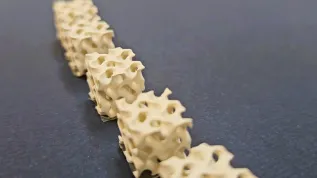
Technologies originally created for use in space have found applications on Earth many times. According to Wiktoria Dziaduła from the Silesian University of Technology, architecture should also follow this direction, especially in the context of self-sufficiency and ecology of the entire life cycle of buildings.
Dziaduła devoted her doctorate to architecture in extreme conditions (where the parameters for living and working are suboptimal, even extreme), especially the aspect of self-sufficiency on the example of space facilities.
As the doctoral candidate explains in an interview with PAP - Science in Poland, it is an interdisciplinary topic, combining architecture with such areas as environmental engineering, construction, logistics and psychology. The area of her main research interests are technologies that can be transferred from space or extreme conditions to sustainable construction on Earth.
'I pay a lot of attention to the very philosophy of building. For example, when designing a base on the Moon, we have to think about how to transport all these raw materials and components, what materials can be used on site, how the construction stage itself should proceed. We want to do all that at the lowest financial and environmental cost. I believe that we should have a similar approach here on Earth, because the current environmental costs of construction are huge,’ says Dziaduła.
She adds that it is crucial to think about the entire life cycle of the building - from the moment of creating the concept, through planning the supply of materials, to pro-ecological solutions already during the use of the space.
One such technology, which has been used in space technologies for a long time and is now gaining popularity on Earth, is the closed water circulation in buildings, with particular emphasis on the reuse of grey water (water from washbasins and showers, which can be reused, for example for flushing). 'Such solutions, e.g. washbasins connected to the toilet, are already available. The next step would be to filter this grey water so that it is also safe for preparing meals or watering plants. In space, this is forced by the lack of running water, but we should think more and more about how and how much of it we use every day,’ says Dziaduła.
Another issue is logistics. 'One of the biggest challenges of building objects in space is the problem of transporting materials, for example to the Moon. One of the currently developed technologies is the ability to print building elements with 3D printers, using the raw material available on site, e.g. lunar regolith. By transferring this problem here, to Earth, our choices - for example, regarding the transport of building materials - should also be made taking into account the environmental cost and the possibility of using locally sourced materials,’ she says.
According to Dziaduła such thinking fits in with the sustainable policy of the European Union and the regulations related to it that are gradually being implemented. 'The environmental impact of building construction is huge and requires the introduction of new regulations. The goals are ambitious, but it is still difficult to find a specific way and specific solutions that could allow to achieve them. Perhaps this is a good time to turn towards and get inspired by space technology,’ she says.
In her opinion, the barrier to the wider use of these technologies is insufficient education of architects and investors. 'The former,’ she says, ‘have often not heard of the solutions that are already available. The latter, on the other hand, must be willing to invest more money, which will pay off sooner or later, for example in the form of smaller bills or a smaller negative impact on the environment,’
Two years ago, during her master's studies, Dziaduła spent two weeks in a simulated space mission in the Lunares habitat. 'In extreme conditions, everything seems clearer and easier to study, starting with human functioning in a confined space. Thanks to this experience, I learned about the extraordinary influence of plants on human mental comfort,’ she says.
When asked what an architect can contribute to space engineering, she replies that it is primarily human-centred design. 'As an example, I will recall a legend circulating in the community that during the first orbital flights there were supposed to be no windows on spacecrafts, because the engineers claimed that it would threaten the safety of astronauts. Of course, this is an element that requires a lot of engineering work, but without the lobbying of architects at the time, we wouldn't have had so many beautiful photos taken through these windows.
'Many people ask me why I do space architecture - something so far removed from earthly reality. However, I see here great opportunities to be inspired by what is good and proven in space. First of all, I would like the designed and constructed buildings to be as self-sufficient, and their exploitation - as independent as possible from external resources.’
In October, thanks to a scholarship from the Kościuszko Foundation, Dziaduła will start a three-month internship at the University of Houston in the United States. Houston is a global space technology hub.
PAP - Science in Poland, Agnieszka Kliks-Pudlik
akp/ zan/ kap/
tr. RL













